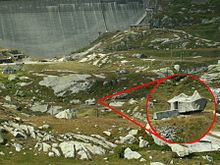Reduit

Commonly, the réduit is a fortified defence structure which is used in order that the defending troops can survive and hold out an attack.
Classical fortifications
A réduit is a fortification which provides protection during a persistent attack. A citadel, for example, is the réduit of a classical fortification.
Meaning during the Second World War
During World War II, "réduit" referred to the concept of a heavily defended, "untakeable" region of a country which provided a last hard spot of resistance, and hopefully a base for a counter-attack, should a large part of a country be invaded.
During the Battle of the Netherlands, the last province to resist invasion was Zeeland, which was the only part of the country not to surrender after the bombing of Rotterdam.
In France, when it became clear that the Battle of France could not be won against the Nazis, the idea of a "réduit" in Brittany was suggested as an alternative to letting the whole mainland France at the hands of the invaders.
For Switzerland, a neutral country then surrounded by a Nazi-occupied Europe which had witnessed the astonishing fall of France, defence was quickly re-designed and articulated over the idea of a réduit in the Swiss Alps.
Réduit in the Swiss Alps

In Switzerland, the concept of "réduit" is a recurring theme of the Swiss concept of defence. Having avoided fighting during World War II, Switzerland retained the concept for its plans of resistance against a putative Soviet invasion, thus shaping a part of the national folklore, and a strong influence in the Swiss concept of neutrality.
History
Switzerland's Réduit strategy during World War II was essentially one of deterrence. The idea was to make clear to the Third Reich that an invasion would have a high cost. Simultaneously, economic concessions were made to Germany in the hope that the overall cost of a German invasion would be perceived as higher than the potential benefits. Despite this, it is clear that Hitler intended to invade eventually and that the Allied landing at Normandy as well as the difficulties faced in invading Russia were pivotal in merely delaying an invasion[1].
After Switzerland was surrounded by German and Italian forces, General Henri Guisan revealed on 25 July 1940 at the so-called Rütlirapport, a meeting of the Swiss army staff at the founding site of the Swiss confederation, that in case of attack the Swiss would only defend the high Alps including the important transalpine roads and rail links. As a last resort, the army would make these routes useless to the Axis by destroying key bridges and tunnels. This plan meant that the populated lowlands - including the economic centres of the country - would be effectively ceded to the Germans. The gold reserves of the Swiss National Bank in Zürich were moved farther away from the German border, to the Gotthard Pass and to Bern[2].
Many billions of Swiss Francs have been invested in building the fortifications in the mountains, which are partly still used by the army. The most important buildings of the Réduit were the fortifications of Sargans, St. Maurice (Valais) and the Gotthard region. The caverns of those time were equipped with the needed infrastructure, beside cannons and howitzers they consisted of dormitories, kitchens, field hospitals, rooms for the sick and bakeries; and they provided space enough to accommodate 100 to 600 soldiers for a timespan of up to several months. Because the tensions between the western countries and the USSR cooled down and bunkers became more or less obsolete because of newer weapon systems, a great number of the Réduit buildings were closed. Some of them have been reopened as museums and can be visited.
Folklore and myths

As a result of the strict secrecy, many myths and legends were born. One of them says that a secret airport was constructed in a mountain, and that the aircraft would leave and enter the fortification by large holes or even by aircraft carrier-like catapults - but this myth may have been born because actually some military airfields are located adjacent to caverns, where aircraft and maintenance personnel can be sheltered; and the airfield of Meiringen is an example of this. (It is true that one of today's Swiss Air Force fighter aircraft - the F/A-18 - is a naval airplane, still having tailhooks. Older airplanes like the de Havilland Vampire were also naval fighters, required by the often short runways in the Alps.) Another myth says that one could march right through the Alps because the army built so many caverns. However, it is possible to spot many "secret" army buildings while hiking or travelling in the Swiss Alps. They can often be found where alpine passes or narrow passages into or within valleys had to be protected.
Because the Réduit strategy was essentially one of deterrence, part of it was overt and public, and played a part in the so-called "intellectual defence of the homeland", or Geistige Landesverteidigung attempting to improve the morale and cohesiveness of the nation. The Réduit strategy's use as a deterrence/propaganda tool continued through the cold war. In 1964, the army's pavilion at the Swiss Fair (Landesausstellung) in Lausanne had the shape of a giant hedgehog made of concrete.
